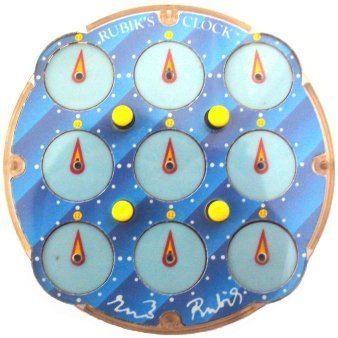 | ||
Rubik's Clock is a mechanical puzzle invented and patented by Christopher C. Wiggs and Christopher J. Taylor. The Hungarian sculptor and professor of architecture Ernő Rubik bought the patent from them to market the product under his name. It was first marketed in 1988.
Contents
Rubik's Clock is a two-sided puzzle, each side presenting nine clocks to the puzzler. There are four wheels, one at each corner of the puzzle, each allowing the corresponding corner clock to be rotated directly. (The corner clocks, unlike the other clocks, rotate on both sides of the puzzle simultaneously and can never be operated independently. Thus the puzzle contains only 14 independent clocks.)
There are also four buttons which span both sides of the puzzle; each button arranged such that if it is "in" on one side it is "out" on the other. The state of each button (in or out) determines whether the adjacent corner clock is mechanically connected to the three other adjacent clocks on the front side or on the back side: thus the configuration of the buttons determines which sets of clocks can be turned simultaneously by rotating a suitable wheel.
The aim of the puzzle is to set all nine clocks to 12 o'clock (straight up) on both sides of the puzzle simultaneously.
Combinations
Since there are 14 independent clocks, with 12 settings each, there is a total of 14^12=1,283,918,464,548,864 possible combinations.
Records
The current world record for single solve is 3.73 seconds, done by Nathaniel Berg at Danish Open 2015. The current world record average of 5 (dropping best and worst singles) is 5.33 seconds, done by Evan Liu at Birmingham Open 2016.
